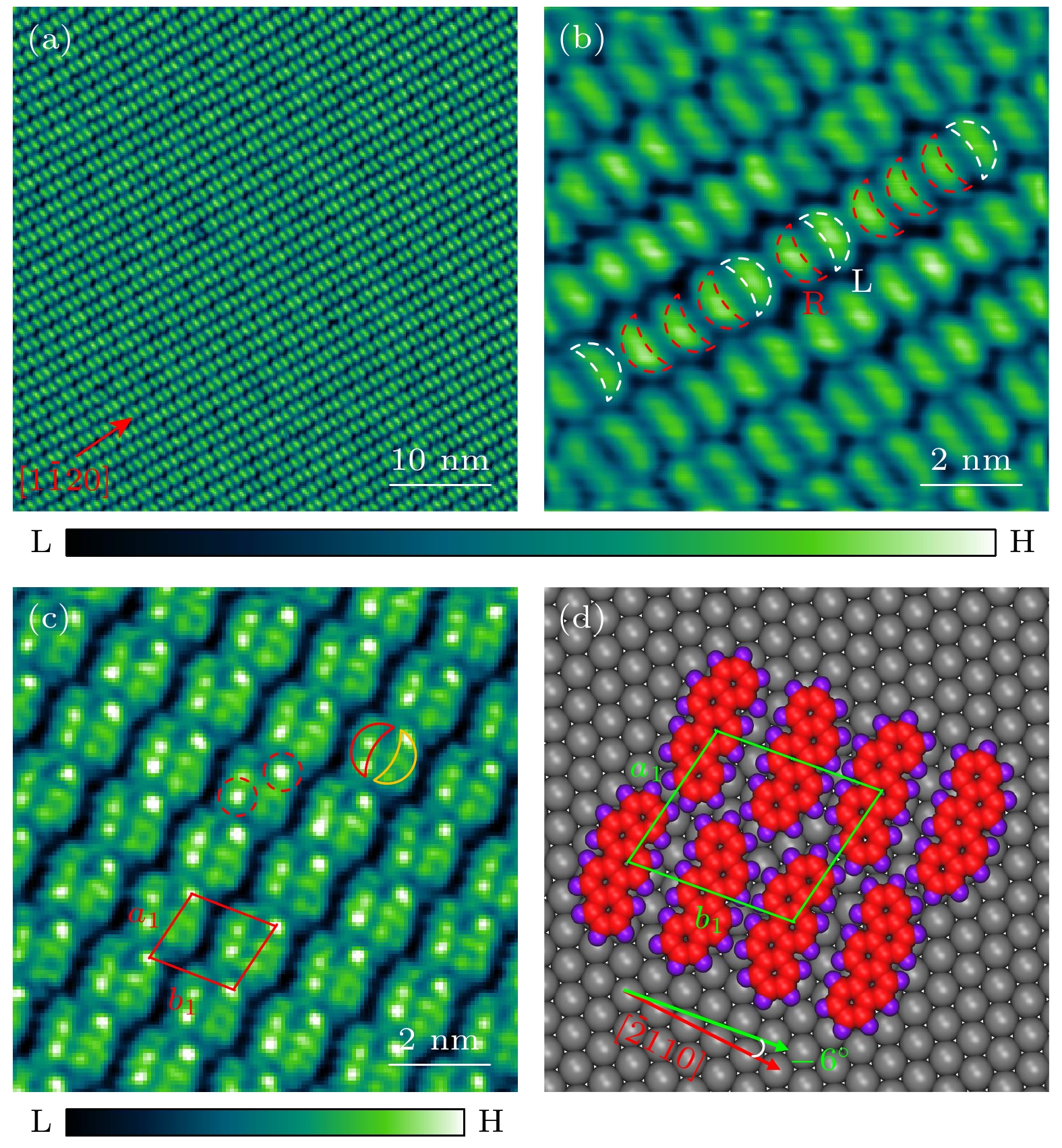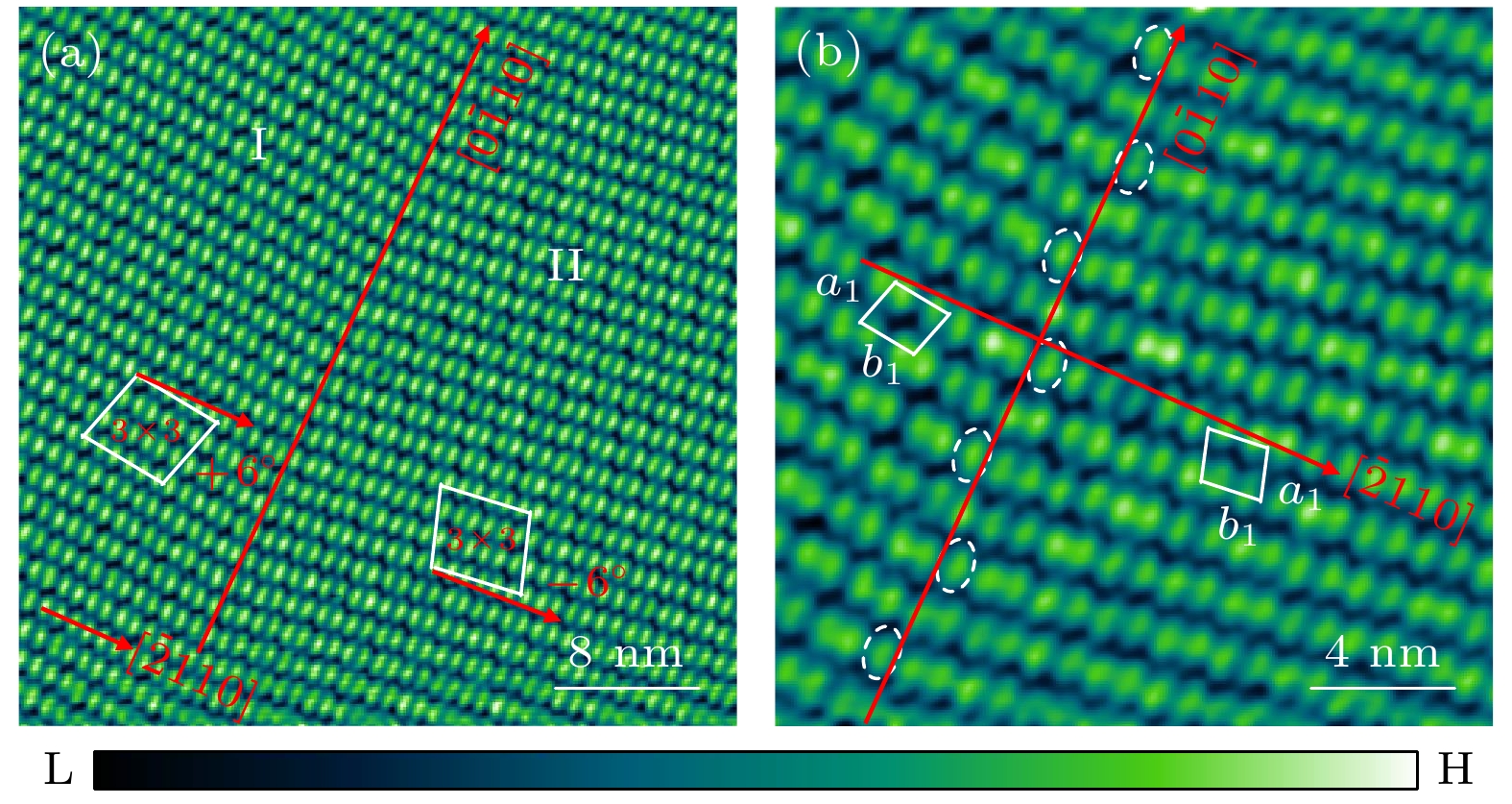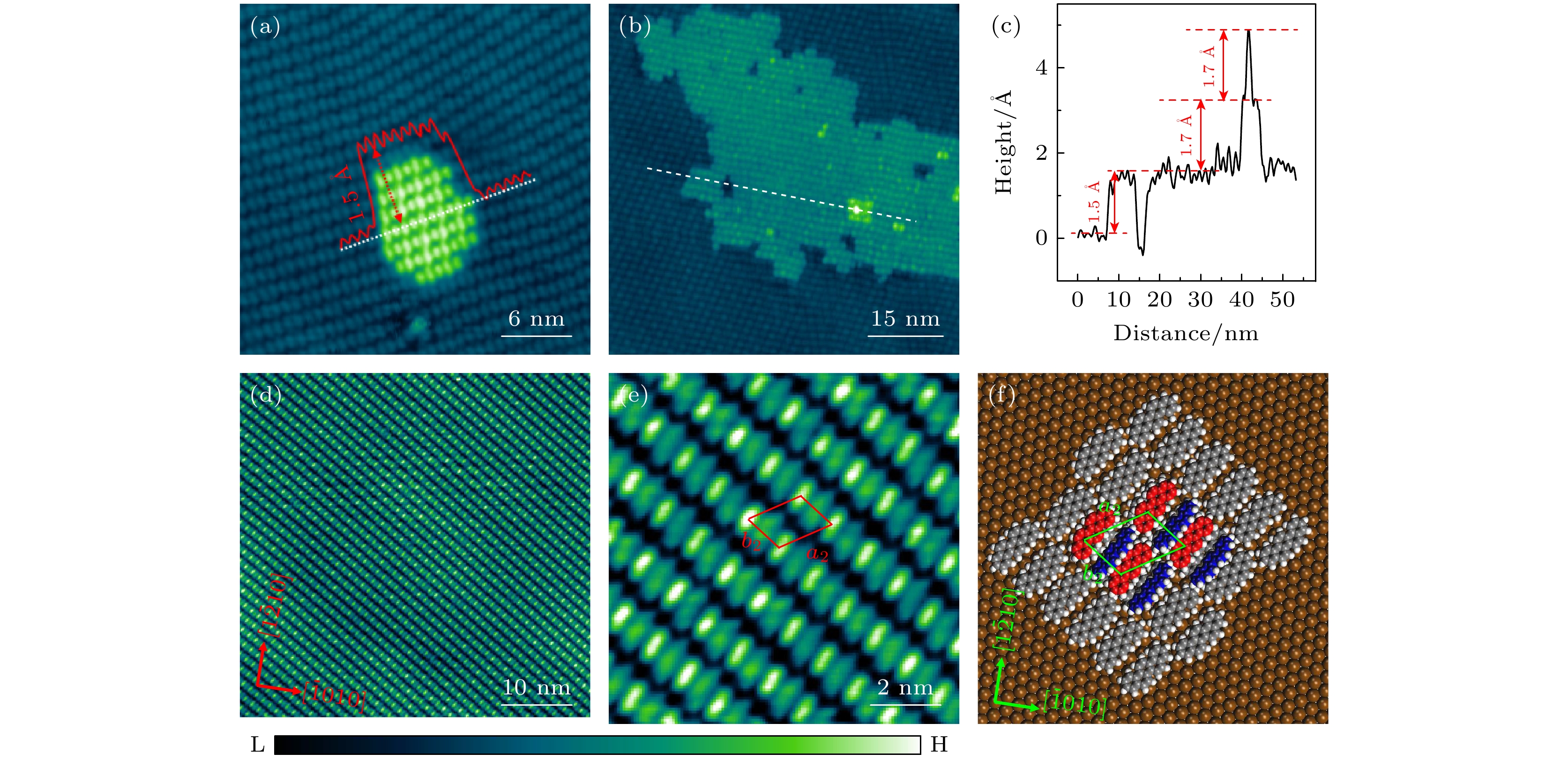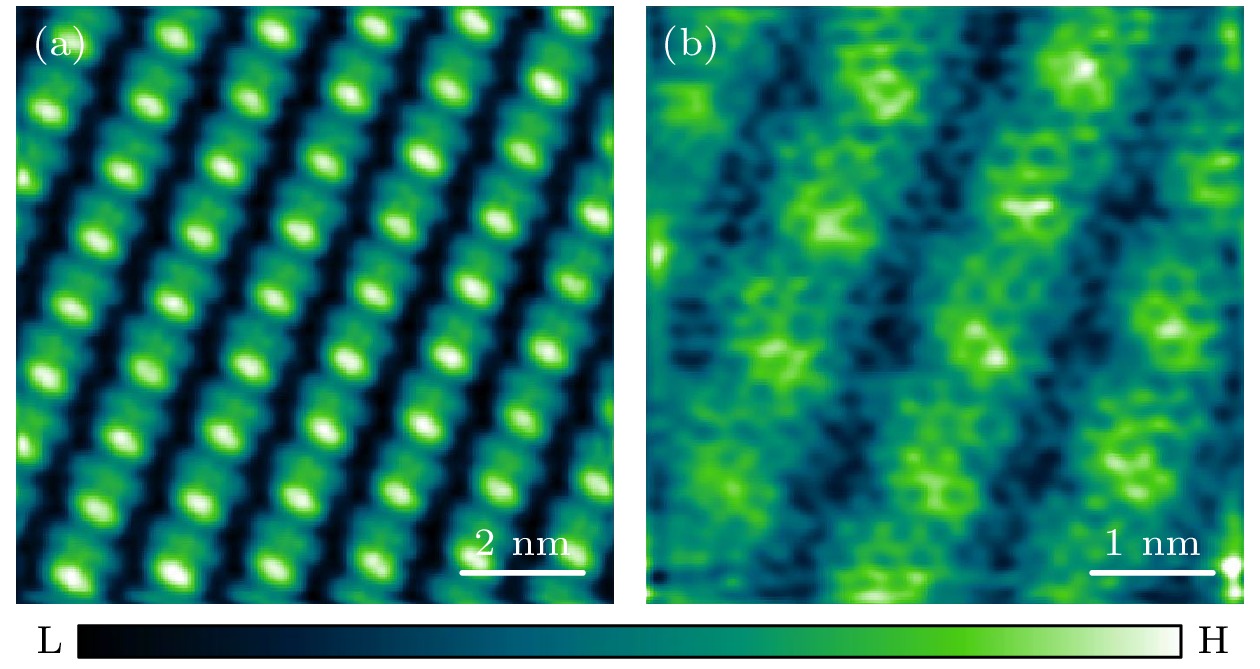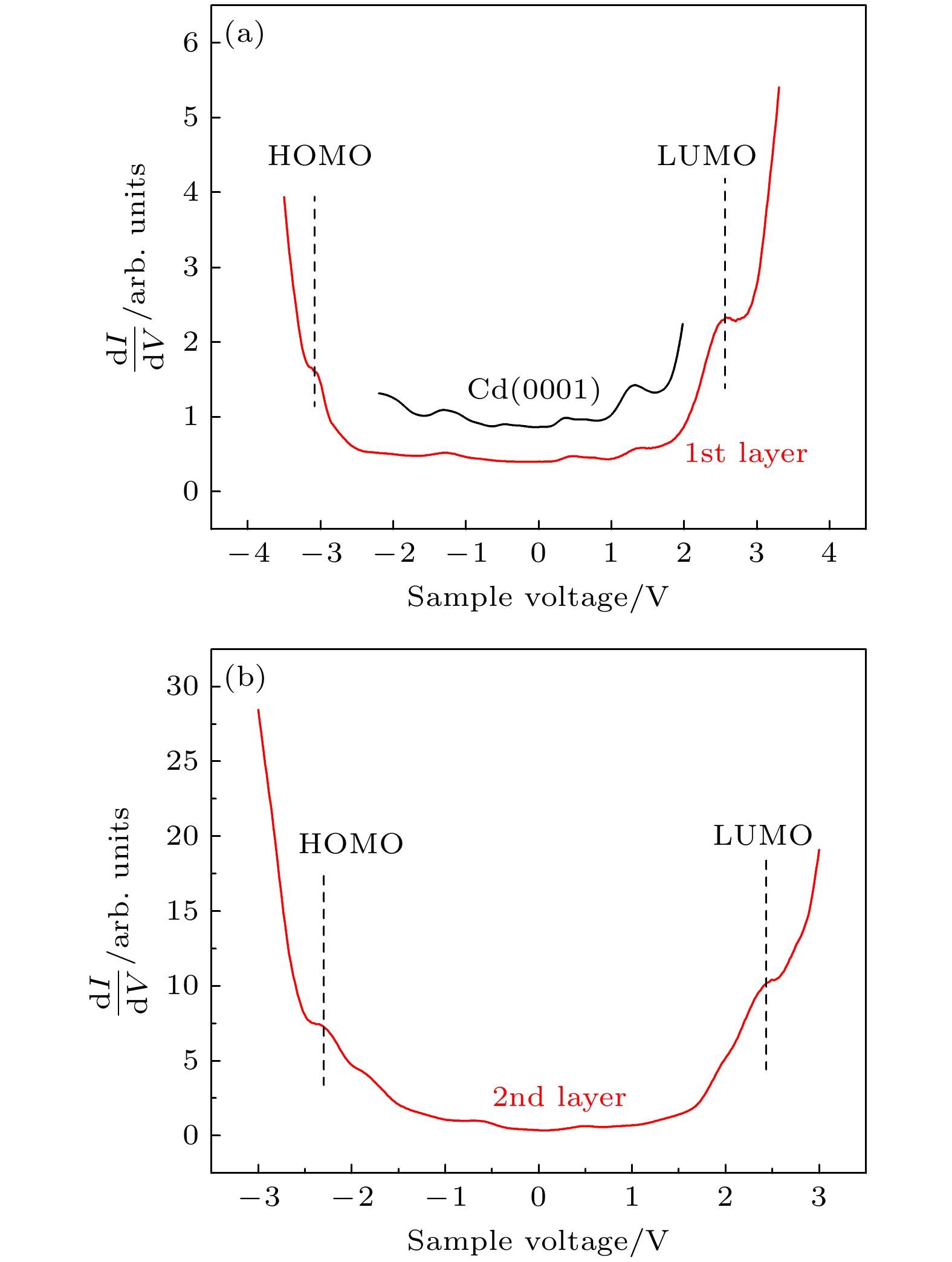-
本文利用低温扫描隧道显微镜(STM)研究了苉分子在Cd(0001)量子阱薄膜上的自组装和薄膜生长. 在亚单层的覆盖度, 苉分子会铺满整个衬底表面并形成无序的二维分子气, 表明苉分子之间存在静电排斥力. 随着覆盖度的增加, 第1层分子会发生无序-有序相变, 形成由平躺分子组成的分子带平行阵列. 高分辨的STM图表明, 分子带的基本结构单元是携带相反电偶极矩的苉二聚体. 更重要的是, 在特定的偏压下第1层分子带会出现电子透射现象: 可以透过分子层看到下面的Cd衬底原子. 当覆盖度超过1.0 分子单层, 第2层苉分子也会形成分子带阵列, 其基本单元是一个平躺分子和一个侧立分子组成的二聚体, 类似于苉晶体中的(110)面. 有趣的是, 第2层苉分子带也出现了电子透射现象. 以上结果表明, Cd(0001)薄膜中的量子阱态上的电子具有超强的穿透能力, 其竖直隧穿长度达到了两个苉分子层的距离.
The thin films of picene on the Cd(0001) surface are investigated by scanning tunneling microscopy (STM) in this work. Compared with conventional noble metal substrates such as Au, Ag, and Cu, Cd(0001) has low electronegativity and small work function , which can effectively weaken the molecule-substrate interactions, thereby promoting the intermolecular van der Waals attraction. The experiments are conducted by ultrahigh vacuum low-temperature STM combined with a molecular beam epitaxy system. The crystalline Cd(0001) films are grown on a surface of Si(111)-7×7 by depositing 15-20 monolayers of Cd atoms, followed by being annealed. The picene molecules are deposited on the Cd(0001) surface at 100–120 K, where monolayer (ML) is defined as the critical coverage before second-layer nucleation. All STM measurements are acquired in constant-current mode. It is observed that, in the submonolayer regime, the picene molecules occupy the entire substrate surface and form disordered two-dimensional molecular gas, indicating the existence of electrostatic repulsive interaction among picene molecules. With the coverage increasing, the first layer of molecules undergoes the disorder-order transition, forming the parallel array of molecular stripes of flat-lying molecules. The high-resolution STM images show that the building block of molecular stripes is a picene dimer with the opposite dipole moments. More importantly, under a specific bias voltage, the first layer of molecular stripes exhibits electronic transmission: not only can the underlying Cd substrate atoms be observed, but also the standing waves of scattered electrons can be observed near the defects. When the coverage exceeds 1.0 ML, the second picene layer also forms the stripe array composed of picene dimers of a flat-lying and a side-on molecules, similar to the (110) plane in picene crystals. The above results show that the electrons from the quantum-well states of Cd (0001) thin film have very strong penetration ability, and their vertical tunneling length reaches to the distance of two molecular layers. -
Keywords:
- picene molecules /
- scanning tunneling microscopy /
- dipole-dipole interaction /
- electronic transmission
[1] Heringdorf F, Reuter M C, Tromp R M 2001 Nature 412 517
 Google Scholar
Google Scholar
[2] Sundar V C, Zaumseil J, Podzorov V, Menard E, Willett R L, Someya T, Gershenson M E, Rogers J A 2004 Science 303 1644
 Google Scholar
Google Scholar
[3] Ueno N, Kera S 2008 Prog. Surf. Sci. 83 490
 Google Scholar
Google Scholar
[4] Shirota Y, Kageyama H 2007 Chem. Rev. 107 953
 Google Scholar
Google Scholar
[5] Coropceanu V, Cornil J, da Silva D A, Olivier Y, Silbey R, Brédas J L 2007 Chem. Rev. 107 926
 Google Scholar
Google Scholar
[6] De A, Ghosh R, Roychowdhury S, Roychowdhury P 1985 Acta Crystallogr. Sect. C-Cryst. Struct. Commun. 41 907
 Google Scholar
Google Scholar
[7] Okamoto H, Kawasaki N, Kaji Y, Kubozono Y, Fujiwara A, Yamaji M 2008 J. Am. Chem. Soc. 130 10470
 Google Scholar
Google Scholar
[8] Nguyen T P, Shim J H, Lee J Y 2015 J. Phys. Chem. C 119 11301
 Google Scholar
Google Scholar
[9] Kawai N, Eguchi R, Goto H, Akaike K, Kaji Y, Kambe T, Fujiwara A, Kubozono Y 2012 J. Phys. Chem. C 116 7983
 Google Scholar
Google Scholar
[10] Teranishi K, He X X, Sakai Y, Izumi M, Goto H, Eguchi R, Takabayashi Y, Kambe T, Kubozono Y 2013 Phys. Rev. B 87 060505
 Google Scholar
Google Scholar
[11] Mitsuhashi R, Suzuki Y, Yamanari Y, Mitamura H, Kambe T, Ikeda N, Okamoto H, Fujiwara A, Yamaji M, Kawasaki N, Maniwa Y, Kubozono Y 2010 Nature 464 76
 Google Scholar
Google Scholar
[12] Zhou C S, Shan H, Li B, Zhao A D, Wang B 2016 Appl. Phys. Lett. 108 171601
 Google Scholar
Google Scholar
[13] Zhang C Y, Tsuboi H, Hasegawa Y, Iwasawa M, Sasaki M, Wakayama Y, Ishii H, Yamada Y 2019 ACS Omega 4 8669
 Google Scholar
Google Scholar
[14] Yano M, Endo M, Hasegawa Y, Okada R, Yamada Y, Sasaki M 2014 J. Chem. Phys. 141 034708
 Google Scholar
Google Scholar
[15] Shao X J, Ma X H, Liu M J, Zhang T, Ma Y P, Xu C Q, Wu X F, Lin T, Wang K D 2020 Chem. Phys. 532 110689
 Google Scholar
Google Scholar
[16] Liu G W, Shao X J, Xu C Q, Wu X F, Wang K D 2020 J. Phys. Chem. C 124 22025
 Google Scholar
Google Scholar
[17] Hasegawa Y, Yamada Y, Hosokai T, Koswattage K R, Yano M, Wakayama Y, Sasaki M 2016 J. Phys. Chem. C 120 21536
 Google Scholar
Google Scholar
[18] Yoshida Y, Yang H H, Huang H S, Guan S Y, Yanagisawa S, Yokosuka T, Lin M T, Su W B, Chang C-S, Hoffmann G, Hasegawa Y 2014 J. Chem. Phys 141 114701
 Google Scholar
Google Scholar
[19] Kelly S J, Sorescu D C, Wang J, Archer K A, Jordan K D, Maksymovych P 2016 Surf. Sci. 652 67
 Google Scholar
Google Scholar
[20] Huempfner T, Hafermann M, Udhardt C, Otto F, Forker R, Fritz T 2016 J. Chem. Phys 145 174706
 Google Scholar
Google Scholar
[21] Wakita T, Okazaki H, Jabuchi T, Hamada H, Muraoka Y, Yokoya T 2017 J. Phys. Condes. Matter 29 064001
 Google Scholar
Google Scholar
[22] Hosokai T, Hinderhofer A, Bussolotti F, Yonezawa K, Lorch C, Vorobiev A, Hasegawa Y, Yamada Y, Kubozoro Y, Gerlach A, Kera S, Schreiber F, Ueno N 2015 J. Phys. Chem. C 119 29027
 Google Scholar
Google Scholar
[23] Peng Z T, Di B, Zhao X W, Lin Y X, Diao M X, Xu Z, Guo W J, Zhou X, Chen Q W, Wang Y F, Wu K 2022 J. Phys. Chem. C 126 17753
 Google Scholar
Google Scholar
[24] Hosokai T, Hinderhofer A, Vorobiev A, Lorch C, Watanabe T, Koganezawa T, Gerlach A, Yoshimoto N, Kubozono Y, Schreiber F 2012 Chem. Phys. Lett. 544 34
 Google Scholar
Google Scholar
-
图 1 亚单层覆盖度下苉分子气相和分子带阵列 (a) Cd(0001)薄膜的形貌图(4.0 V, 50 pA), 插图为Cd(0001)薄膜的原子分辨像(3 nm × 3 nm, 0.01 V, 250 pA); (b) 覆盖度为0.4 ML时形成的二维分子气和较短的分子带(2.0 V, 20 pA); (c), (d)为覆盖度为0.8 ML时苉分子形成的大面积分子带及晶格转动(3.0 V, 50 pA)
Fig. 1. Gas phase and molecular stripe arrays of picene formed at submonolayer: (a) Topographic image of Cd(0001) thin films (4.0 V, 50 pA). Insert is the atomic-resolution image of Cd(0001) thin films (3 nm × 3 nm, 0.01 V, 250 pA); (b) 2D molecular gas and short stripes of picene formed at 0.4 ML (2.0 V, 20 pA); (c), (d) the large-scale of molecular stripe arrays and lattice rotation at 0.8 ML (3.0 V, 50 pA).
图 2 第1层分子形成的分子带阵列 (a) 低温沉积形成的大面积分子带阵列 (1.0 V, 20 pA); (b) 分子带阵列的放大图(1.0 V, 20 pA), R型和L型分子的排列具有一定的随机性; (c) 退火后的苉分子带阵列 (3.5 V, 20 pA); (d) 苉分子带阵列的结构模型图
Fig. 2. Molecular stripe array of the first layer: (a) Large-scale of molecular stripe array by LT deposition (1.0 V, 20 pA); (b) close-up view of the picene stripe array (1.0 V, 20 pA), the arrangement of the R-type and L-type molecules exhibiting randomness; (c) picene stripe array after RT annealing (3.5 V, 20 pA); (d) schematic model of the picene stripe array.
图 3 第1层苉分子层形成的镜像畴 (a) 苉分子带阵列的两个镜像畴(1.0 V, 50 pA), 畴区边界是沿衬底晶格[$0 \bar{1} 10$]方向的一条直线; (b) 两个镜像畴的放大图(3.2 V, 50 pA), 畴界两侧分布着未成对的单个苉分子(虚线椭圆内)
Fig. 3. The mirror domain formed by the first layer of picene molecules: (a) Two mirror domains of the stripe array (1.0 V, 50 pA), domain boundary is a straight line along the [$0 \bar{1} 10$] direction; (b) close-up view of the two mirror domains (3.2 V, 50 pA), the unpaired monomers appear at the two sides of domain boundary (marked by dotted ovals).
图 4 苉分子带的电子透射现象 (a) 缺陷周围的苉分子带的正偏压STM图像 (1.2 V, 20 pA); (b)苉分子带的负偏压图像 (–2.3 V, 20 pA), Cd(0001)衬底原子清晰可见, 缺陷附近隧穿结的高度受到了缺陷分子的影响而产生的亮条纹; (c) 偏压恢复到1.2 V时的苉分子带图像 (1.2 V, 20 pA)
Fig. 4. Electronic transmission of the picene stripe array: (a) Positive bias image of the picene stripe array around a defect (1.2 V, 20 pA); (b) negative bias image of the picene stripe array (–2.3 V, 20 pA), the atoms of Cd(0001) are visible, and standing waves of scattered electrons formed around the defect; (c) image of the picene stripe array after the bias is recovered to 1.2 V(1.2 V, 20 pA).
图 5 第2层分子形成的分子带阵列 (a) 覆盖度为1.1 ML时形成的第2层分子岛 (2.0 V, 20 pA); (b) 覆盖度为1.4 ML时形成的第2层和第3层分子岛 (2.0 V, 20 pA); (c) 沿(b)图中白色虚线所做的高度投影图; (d) 覆盖度为2.2 ML时形成的大面积第2层分子带 (1.2 V, 20 pA); (e) 第2层分子带的高分辨STM图像(0.9 V, 20 pA); (f) 第2层分子带与于第1层分子和衬底晶格的结构关系图
Fig. 5. Picene stripe array of second layer: (a) The second layer island formed at 1.1 ML (2.0 V, 20 pA); (b) islands of the second and third layers formed at 1.4 ML (2.0 V, 20 pA); (c) profile line along the dotted line in (b); (d) large scale of the second layer stripe array formed at 2.2 ML (1.2 V, 20 pA); (e) high-resolution image of the second layer stripe (0.9 V, 20 pA); (f) schematic structural model of the second layer stripe relative to the first picene layer and Cd(0001) substrate.
图 6 第2层苉分子带的电子透射现象 (a) 第2层分子带的正偏压STM图像(0.5 V, 20 pA); (b) 第2层分子带的负偏压STM图像(–3.0 V, 20 pA), 苉分子的图像和衬底原子的图像叠加在一起
Fig. 6. Electronic transmission of the second layer stripes: (a) The positive bias image of the second layer stripes (0.5 V, 20 pA); (b) the negative bias image of the second layer stripes (–3.0 V, 20 pA), the protrusions of picene molecules are superposed with those of substrate atoms.
-
[1] Heringdorf F, Reuter M C, Tromp R M 2001 Nature 412 517
 Google Scholar
Google Scholar
[2] Sundar V C, Zaumseil J, Podzorov V, Menard E, Willett R L, Someya T, Gershenson M E, Rogers J A 2004 Science 303 1644
 Google Scholar
Google Scholar
[3] Ueno N, Kera S 2008 Prog. Surf. Sci. 83 490
 Google Scholar
Google Scholar
[4] Shirota Y, Kageyama H 2007 Chem. Rev. 107 953
 Google Scholar
Google Scholar
[5] Coropceanu V, Cornil J, da Silva D A, Olivier Y, Silbey R, Brédas J L 2007 Chem. Rev. 107 926
 Google Scholar
Google Scholar
[6] De A, Ghosh R, Roychowdhury S, Roychowdhury P 1985 Acta Crystallogr. Sect. C-Cryst. Struct. Commun. 41 907
 Google Scholar
Google Scholar
[7] Okamoto H, Kawasaki N, Kaji Y, Kubozono Y, Fujiwara A, Yamaji M 2008 J. Am. Chem. Soc. 130 10470
 Google Scholar
Google Scholar
[8] Nguyen T P, Shim J H, Lee J Y 2015 J. Phys. Chem. C 119 11301
 Google Scholar
Google Scholar
[9] Kawai N, Eguchi R, Goto H, Akaike K, Kaji Y, Kambe T, Fujiwara A, Kubozono Y 2012 J. Phys. Chem. C 116 7983
 Google Scholar
Google Scholar
[10] Teranishi K, He X X, Sakai Y, Izumi M, Goto H, Eguchi R, Takabayashi Y, Kambe T, Kubozono Y 2013 Phys. Rev. B 87 060505
 Google Scholar
Google Scholar
[11] Mitsuhashi R, Suzuki Y, Yamanari Y, Mitamura H, Kambe T, Ikeda N, Okamoto H, Fujiwara A, Yamaji M, Kawasaki N, Maniwa Y, Kubozono Y 2010 Nature 464 76
 Google Scholar
Google Scholar
[12] Zhou C S, Shan H, Li B, Zhao A D, Wang B 2016 Appl. Phys. Lett. 108 171601
 Google Scholar
Google Scholar
[13] Zhang C Y, Tsuboi H, Hasegawa Y, Iwasawa M, Sasaki M, Wakayama Y, Ishii H, Yamada Y 2019 ACS Omega 4 8669
 Google Scholar
Google Scholar
[14] Yano M, Endo M, Hasegawa Y, Okada R, Yamada Y, Sasaki M 2014 J. Chem. Phys. 141 034708
 Google Scholar
Google Scholar
[15] Shao X J, Ma X H, Liu M J, Zhang T, Ma Y P, Xu C Q, Wu X F, Lin T, Wang K D 2020 Chem. Phys. 532 110689
 Google Scholar
Google Scholar
[16] Liu G W, Shao X J, Xu C Q, Wu X F, Wang K D 2020 J. Phys. Chem. C 124 22025
 Google Scholar
Google Scholar
[17] Hasegawa Y, Yamada Y, Hosokai T, Koswattage K R, Yano M, Wakayama Y, Sasaki M 2016 J. Phys. Chem. C 120 21536
 Google Scholar
Google Scholar
[18] Yoshida Y, Yang H H, Huang H S, Guan S Y, Yanagisawa S, Yokosuka T, Lin M T, Su W B, Chang C-S, Hoffmann G, Hasegawa Y 2014 J. Chem. Phys 141 114701
 Google Scholar
Google Scholar
[19] Kelly S J, Sorescu D C, Wang J, Archer K A, Jordan K D, Maksymovych P 2016 Surf. Sci. 652 67
 Google Scholar
Google Scholar
[20] Huempfner T, Hafermann M, Udhardt C, Otto F, Forker R, Fritz T 2016 J. Chem. Phys 145 174706
 Google Scholar
Google Scholar
[21] Wakita T, Okazaki H, Jabuchi T, Hamada H, Muraoka Y, Yokoya T 2017 J. Phys. Condes. Matter 29 064001
 Google Scholar
Google Scholar
[22] Hosokai T, Hinderhofer A, Bussolotti F, Yonezawa K, Lorch C, Vorobiev A, Hasegawa Y, Yamada Y, Kubozoro Y, Gerlach A, Kera S, Schreiber F, Ueno N 2015 J. Phys. Chem. C 119 29027
 Google Scholar
Google Scholar
[23] Peng Z T, Di B, Zhao X W, Lin Y X, Diao M X, Xu Z, Guo W J, Zhou X, Chen Q W, Wang Y F, Wu K 2022 J. Phys. Chem. C 126 17753
 Google Scholar
Google Scholar
[24] Hosokai T, Hinderhofer A, Vorobiev A, Lorch C, Watanabe T, Koganezawa T, Gerlach A, Yoshimoto N, Kubozono Y, Schreiber F 2012 Chem. Phys. Lett. 544 34
 Google Scholar
Google Scholar
计量
- 文章访问数: 1125
- PDF下载量: 40
- 被引次数: 0













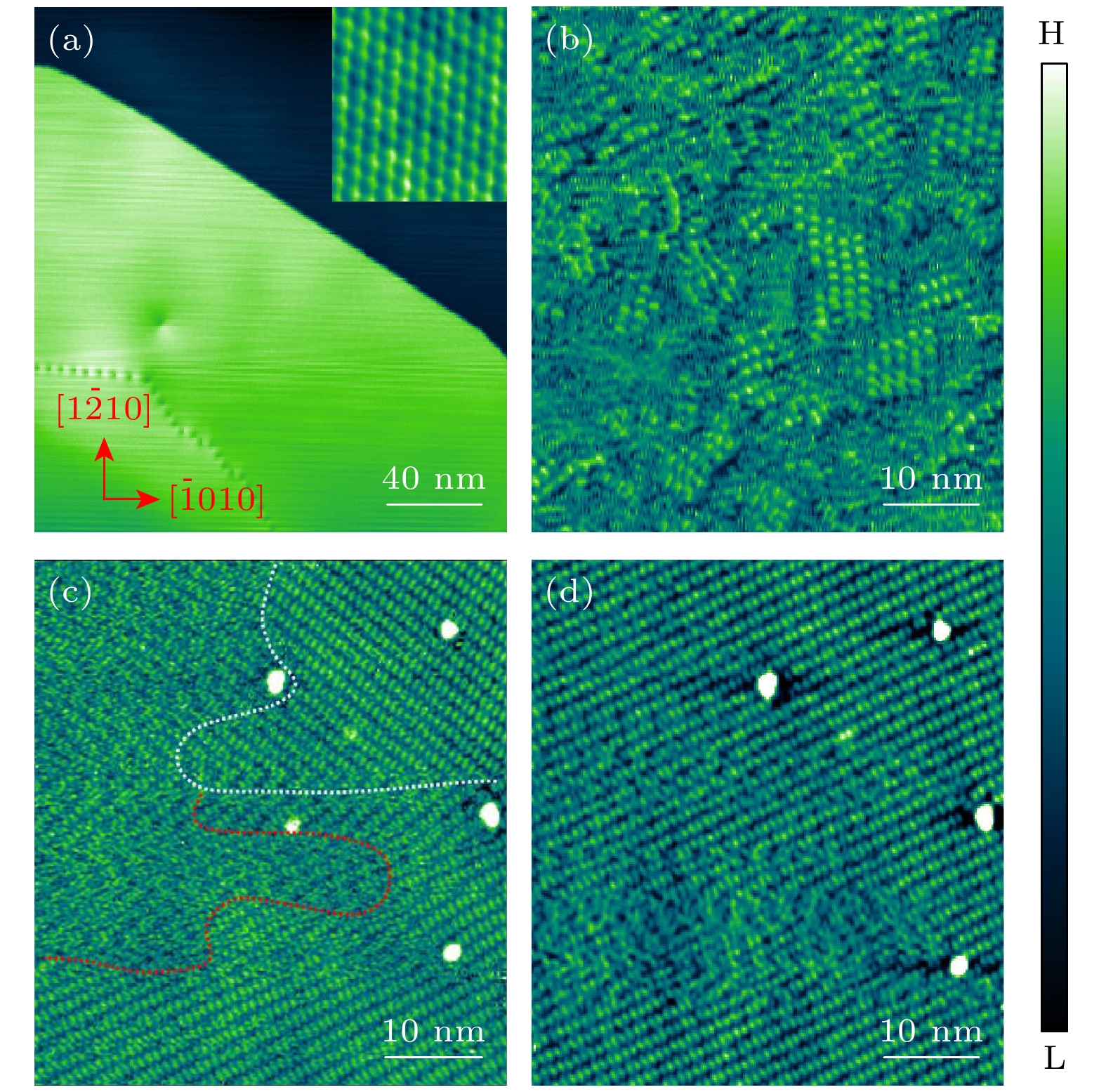
 下载:
下载:
